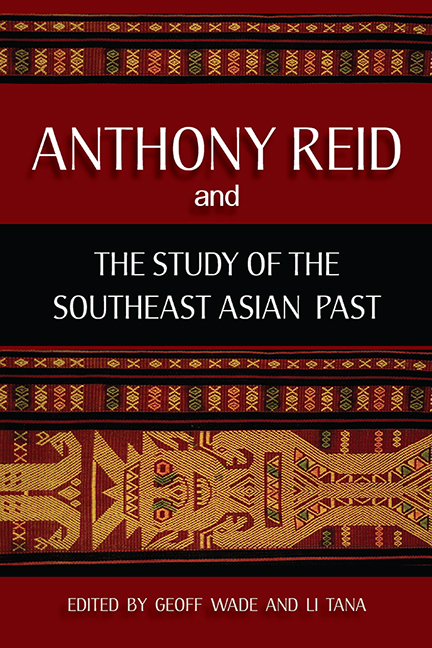Book contents
- Frontmatter
- Contents
- Acknowledgements
- The Contributors
- PART I Introduction
- PART II The Scholarship of Anthony Reid
- PART III Southeast Asia in the World
- PART IV Early Modern Southeast Asia
- 7 Southeast Asian Islam and Southern China in the Fourteenth Century
- 8 Lancaran, Ghurab and Ghali: Mediterranean Impact on War Vessels in Early Modern Southeast Asia
- 9 Weather, History and Empire: The Typhoon Factor and the Manila Galleon Trade, 1565–1815
- 10 Interracial Marriages and the Overseas Family: The Case of the Portuguese Topasses in Timor
- 11 A Note on the Čhām Diaspora in the Ayutthayan Kingdom
- 12 Tongking in the Age of Commerce
- PART V Modern Southeast Asia
- Appendix
- Index
- Plate section
7 - Southeast Asian Islam and Southern China in the Fourteenth Century
from PART IV - Early Modern Southeast Asia
Published online by Cambridge University Press: 21 October 2015
- Frontmatter
- Contents
- Acknowledgements
- The Contributors
- PART I Introduction
- PART II The Scholarship of Anthony Reid
- PART III Southeast Asia in the World
- PART IV Early Modern Southeast Asia
- 7 Southeast Asian Islam and Southern China in the Fourteenth Century
- 8 Lancaran, Ghurab and Ghali: Mediterranean Impact on War Vessels in Early Modern Southeast Asia
- 9 Weather, History and Empire: The Typhoon Factor and the Manila Galleon Trade, 1565–1815
- 10 Interracial Marriages and the Overseas Family: The Case of the Portuguese Topasses in Timor
- 11 A Note on the Čhām Diaspora in the Ayutthayan Kingdom
- 12 Tongking in the Age of Commerce
- PART V Modern Southeast Asia
- Appendix
- Index
- Plate section
Summary
Dedication
Two enduring fields of study for Anthony Reid have been Islam in Southeast Asia — in both historical and contemporary contexts — and the diverse relationships which have long tied Southeast Asia with China. Both aspects found expression in Southeast Asia in the Age of Commerce, as well as in a range of articles and other contributions to scholarship. It was through Tony's encouragement that I began exploring the nexus of these two phenomena, particularly as they existed in the fourteenth century. The following article expands on an idea which Tony first conceived and expounded upon in our conversations. This small piece is dedicated to a man of rare qualities — a scholar whose breadth of interests and extensive scholarly endeavours have done nothing to diminish a deep compassion and concern for others.
Introduction
Islam came to the polities and societies of Southeast Asia by sea, along the girdle of trade which extended from the Arab and Persian worlds through the ports of South Asia, to Southeast Asia and onwards to the southern extensions of the Chinese world in the East China Sea. Islamic influences extended into Southeast Asia from both ends of this trade route in different periods. In examining such influences, the extension of Islam into Southeast Asia prior to 1500 can be divided into three major stages:
The period from the emergence of Islam until the C ōla invasions of Southeast Asia in the eleventh century;
The end of the eleventh century until the thirteenth century;
The fourteenth and fifteenth centuries, following the establishment of the first Islamic Southeast Asian polities in the thirteenth century.
The present paper will focus attention on the early part of the third period, specifically the second half of the fourteenth century, in order to demonstrate how key were events of this period in the Islamization of Southeast Asia. There is little doubt that the earliest introduction of Islam to Southeast Asia was by Muslim merchants who travelled along the maritime routes which, for at least a millennium earlier, had connected the two ends of the Eurasian continent. The foundation of the urban centre of Baghd ād in 762 C.E. — with Basra as its outlet to the Arabian Sea — was a major impetus in the transformation of trade and the development of commerce between the Persian Gulf and East Asia.
- Type
- Chapter
- Information
- Anthony Reid and the Study of the Southeast Asian Past , pp. 125 - 145Publisher: ISEAS–Yusof Ishak InstitutePrint publication year: 2012

